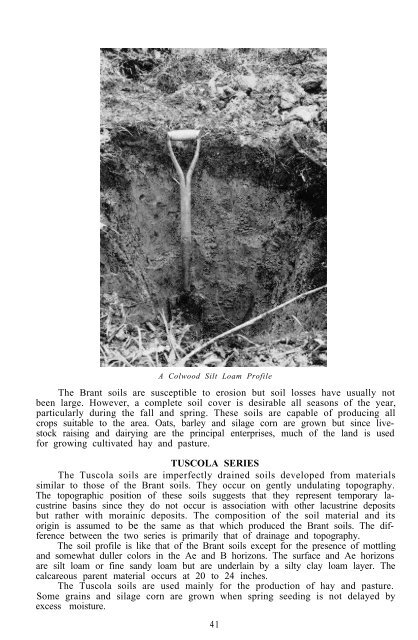Untitled - Agriculture and Agri-Food Canada
Untitled - Agriculture and Agri-Food Canada
Untitled - Agriculture and Agri-Food Canada
You also want an ePaper? Increase the reach of your titles
YUMPU automatically turns print PDFs into web optimized ePapers that Google loves.
A Colwood Silt Loam Profile<br />
The Brant soils are susceptible to erosion but soil losses have usually not<br />
been large. However, a complete soil cover is desirable all seasons of the year,<br />
particularly during the fall <strong>and</strong> spring. These soils are capable of producing all<br />
crops suitable to the area. Oats, barley <strong>and</strong> silage corn are grown but since livestock<br />
raising <strong>and</strong> dairying are the principal enterprises, much of the l<strong>and</strong> is used<br />
for growing cultivated hay <strong>and</strong> pasture.<br />
TUSCOLA SERIES<br />
The Tuscola soils are imperfectly drained soils developed from materials<br />
similar to those of the Brant soils. They occur on gently undulating topography.<br />
The topographic position of these soils suggests that they represent temporary lacustrine<br />
basins since they do not occur is association with other lacustrine deposits<br />
but rather with morainic deposits. The composition of the soil material <strong>and</strong> its<br />
origin is assumed to be the same as that which produced the Brant soils. The difference<br />
between the two series is primarily that of drainage <strong>and</strong> topography.<br />
The soil profile is like that of the Brant soils except for the presence of mottling<br />
<strong>and</strong> somewhat duller colors in the Ae <strong>and</strong> B horizons. The surface <strong>and</strong> Ae horizons<br />
are silt loam or fine s<strong>and</strong>y loam but are underlain by a silty clay loam layer. The<br />
calcareous parent material occurs at 20 to 24 inches.<br />
The Tuscola soils are used mainly for the production of hay <strong>and</strong> pasture.<br />
Some grains <strong>and</strong> silage corn are grown when spring seeding is not delayed by<br />
excess moisture.<br />
41

















